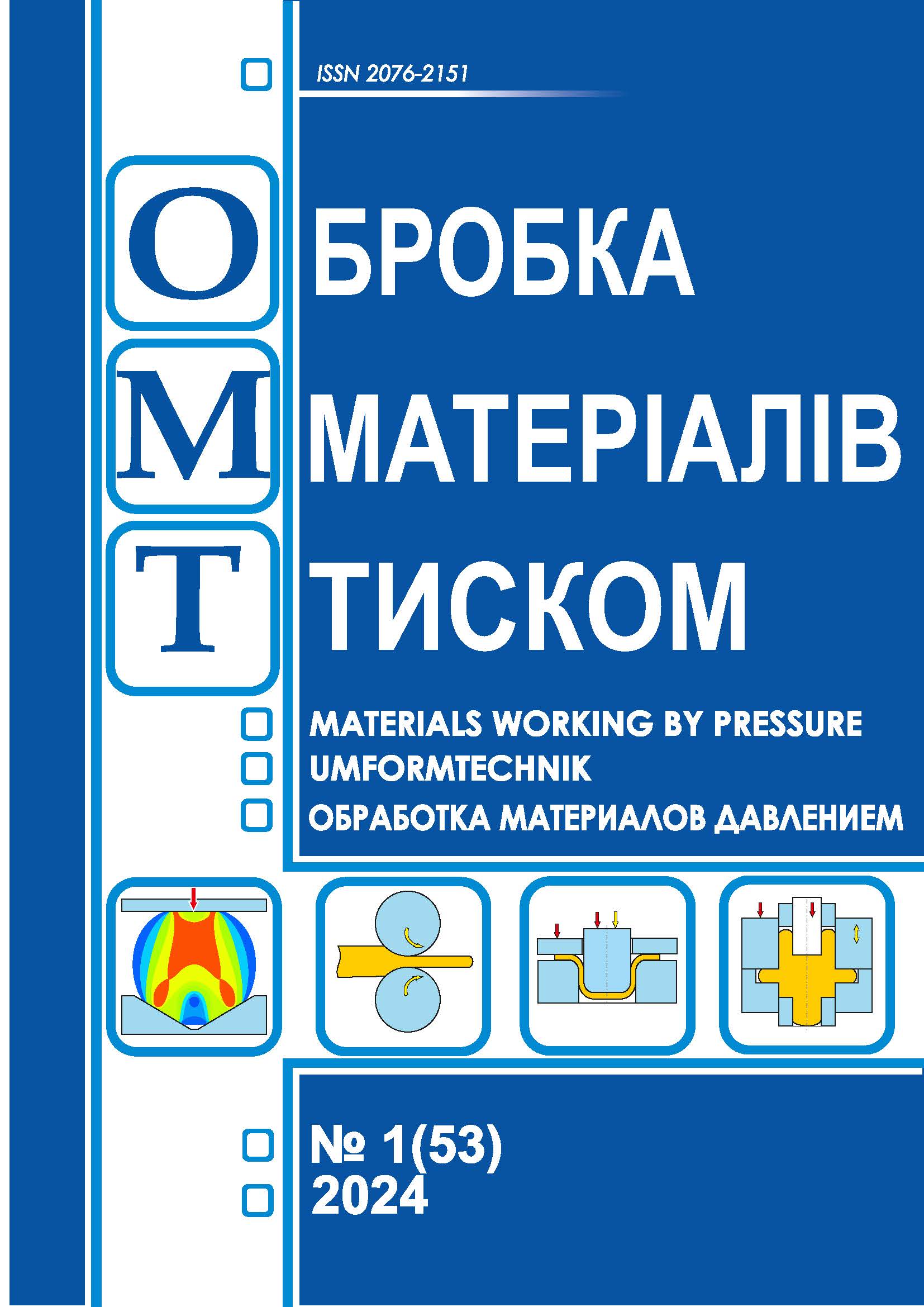Improving the quality of melted metal during the restoration of the working surface of the press tool
DOI:
https://doi.org/10.37142/2076-2151/2024-1(53)188Keywords:
: deforming tool, self-shielded powder wire, non-metallic inclusions, gas saturation of deposited metal, the gas slag-forming component of the flux-cored wire.Abstract
Grin O., Zharikov S.
Improving the quality of melted metal during the restoration of the working surface of the press tool
The analysis of literature data showed that the reliability and efficiency of forging and press production depends on the stability of the deforming tool, the improvement of which is of great technical and economic importance. One of the ways to increase stability is strengthening and restorative surfacing of the working tool with self-shielded flux-cored wire (SFW). One of the disadvantages of SFW is the formation of pores and non-metallic inclusions caused by nitrogen in the deposited metal, the amount of which depends on the effectiveness of the protection of the liquid metal. Gas saturation and the quality of the deposited metal are affected by the gas slag-forming part of the flux-cored wire core. Therefore, an urgent issue is the study of the influence of SFW components on nitrogen and nitride saturation of the molten metal. The saturation of the molten metal with gases occurs both in drops and in the welding bath. When studying the influence of the sheath steel grade on the gas saturation of the deposited metal and the content of non-metallic inclusions, it was found that for SFW sheaths made of 08кп, 08пс, 09Г2 steels, the minimum number of non-metallic inclusions is formed when using a wire with a 09Г2 sheath, while also establishing a minimum solubility of gases in the deposited metal. The analysis of the effect of the gas-slag-forming component of the flux-cored wire on the nitrogen content in the welded metal showed that the ratio of the components: fluorspar CaF2, rutile concentrate TiO2, marble CaCO3 significantly affects the solubility of nitrogen in the weld metal. Based on the results of our research, a mathematical model was obtained that can be used in the optimization of the gas slag-forming part of self-shielded flux cored wires, during the melting of which slags of the main character of the CaO - CaF2 - TiO2 system are formed.deforming tool, self-shielded powder wire, non-metallic inclusions, gas saturation of deposited metal, the gas slag-forming component of the flux-cored wire.
References
Pokhodnia I.K. Metallurgy of arc welding. Kyiv: Naukova dumka. 2004. 430 p. (in Ukranian).
Zharikov S.V., Grin A.G. Investigation of slag in surfacing with exothermic flux-cored wires. Welding International. 2015. 29. 5, pp. 386–389.
Metlitskii V.A. Flux-cored wires for arc welding and surfacing of cast iron. Welding International. 2008. 22, pp. 796–800.
Mendez P.F., Barnes N., Bell K., Borie S.D., Gajapathi S.S., Guest S.D. et al. Welding processes for wear resistant overlays. J Manuf Process. 2014. 16(l), pp 4–12.
Trembach B., Grin A., Makarenko N., Zharikov S., Trembach I., Markov O. Influence of the core filler composition on the recovery of alloying elements during the self-shielded flux-cored arc welding. Journal of Materials Research and Technology. 2020. 9. 5, pp. 10520–10528.
Ioffe I.S., Zelenova V.I. Gas and slag protection against nitrogen formation during welding with self-shielding flux cored wires. Welding production. 1986. 8, pp. 32–35. (in Ukrainian).
Hryn A.G., Karpenko V.M., Boyko I.V. Separation of the slag crust during surfacing with a self-shielding flux-cored wire. Herald of DSEA. 2006. 5, pp. 169–173. (in Ukrainian).
Zharikov S.V. The composition and properties of the slag formed during welding of a die tool with exo-thermic flux cored wire. Protection of metallurgical machines from breakdowns. Mariupol, 2008. 10, pp. 270–273. (in Ukrainian).
Kamkina L.V., Mishalkin A.P., Kamkin V.Yu., Hryshchenko Yu.M., Isayeva L.E. Reduction of the harmful effect of nitrogen on the properties of low-carbon steel 08U by selecting a rational number of nitride-forming ele-ments. Theory and practice of metallurgy. 2019. 6, рр. 16–23. (in Ukranian).
Kalyniuk M., Isakova S., Puzryna L. Analysis of metal powders for the content of oxygen, nitrogen, and hydrogen impurities. Chemical metrology. 2019. 5, pp. 62–68. (in Ukranian).
Kirilyuk G.A., Yuzvenko Yu.A. The interaction of the metal of the electrode and the welding bath with nitrogen during welding with self-shielding flux cored wire. Automatic welding. 1983. 3, pp. 46–47. (in Ukrainian).
Gryn AG., Zharykov S.V., Sotskyi I.M. Increasing the mechanical properties of the working surfaces of machine parts due to the powder-coated wire sheath material. Herald of DSEA. 2018. 2 (44), pp. 35–40. (in Ukranian).
Hryn A.G., Karpenko V.M., Bogutsky A.A., Boyko I.A. Controlling the quality of surfacing through the material of the sheath of flux-cored wire. Herald of DSEA. 2006. 2 (4), pp. 21–26. (in Ukrainian).
Babinets A.A., Ryabtsev I.O. Classification of methods of modification and microalloying of deposited metal. Automatic welding. 2021. 9, pp.3–10. (in Ukranian).
Zhdanov L.A. Strelenko N.M., Netyaga A.V. Thermodynamic modeling of the formation of non-metallic oxide inclusions in the weld metal during electric arc welding under high-silica ceramic fluxes. Bulletin of NTTU "KPI". Mechanical engineering series. 2016. 1 (76), pp 57–64. (in Ukranian).
Pat. 75517 Ukraine, IPС B23 K 35/30. Composition of flux-cored wire / O. G. Hryn, I. O. Boyko,
V. A. Presnyakov, [and others]. Publ. 10.12.2012; Bul. No. 23. .
Pat. 32990 Ukraine, IPC B23 K 35/36. The composition of the electrode coating. M. A. Kalin, M. G. Yefimenko, L. V. Shiryaeva. Publ. 10.06.2008; Bul. No. 11. – 5 p.
Pat. 41190 Ukraine, IPС B23 K 35/30. Powder electrode composition. O.V. Shevchenko, E.I. Donchenko, V.K. Lysak. Publ. 05/12/2009; Bul. No. 9.
Pat. 71039 Ukraine, IPС B23 K 35/22, 35/36. Composition of flux-cored wire. I.K. Pokhodnya, V.M. Shlepakov, S.M. Naumenko. Publ. 11/15/2004; Bul. No. 11.
Pat. 61831 Ukraine, IPС В23 K 35/00. Electrode coating for welding dissimilar steels / K. A. Yushchenko, O. V. Bulat, Yu. M. Kakhovsky, [and others]. Publ. 25.07.2011; Bul. No. 14.
Tararichkin I. O. Statistical methods of ensuring the quality of products of welding production. I.O. Tararichkin. Luhansk: V. Dalya SNU publishing house, 2002. 336 p. (in Ukrainian).

